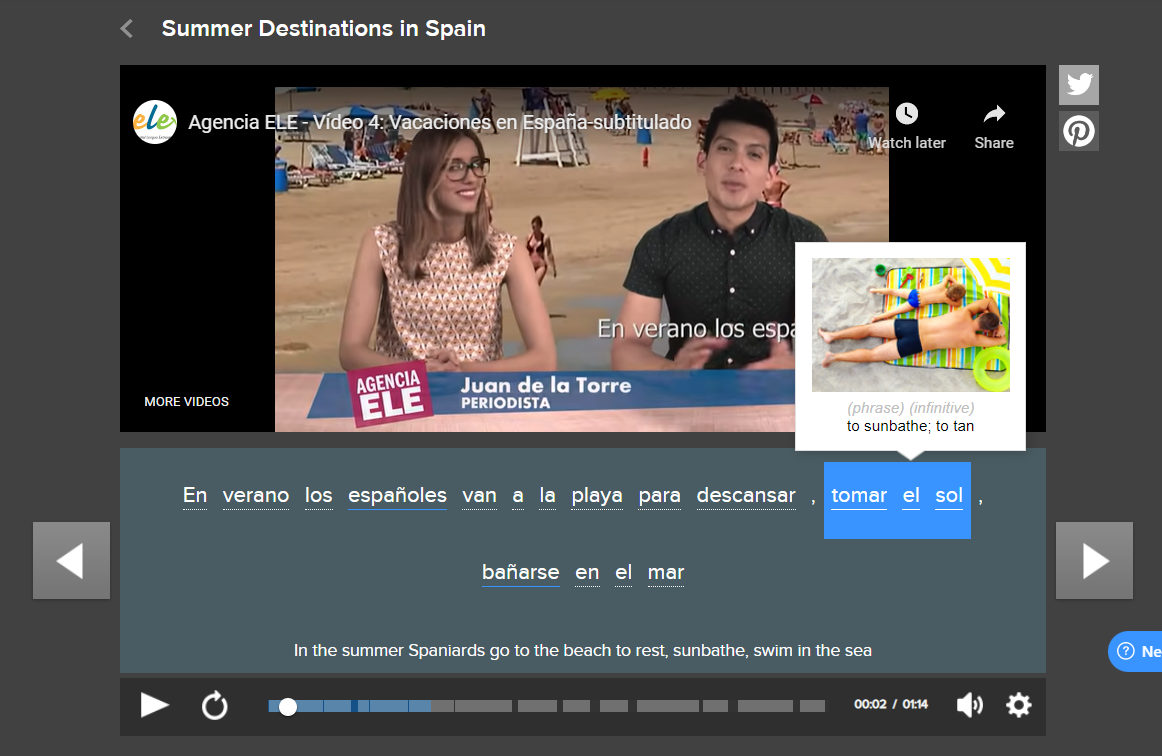
Infinitives are the plain, base forms of Spanish verbs—the forms you see when you pop open a Spanish dictionary or dictionary app.
You might also see them scrawled across the board and at the front of a Spanish classroom, underlined with lists of conjugations underneath.
But what about the infinitive verb itself? We’ll cover how these verb forms are used in Spanish sentences and conversations to express certain ideas.
Contents
Download:
This blog post is available as a convenient and portable PDF that you
can take anywhere.
Click here to get a copy. (Download)
Common Spanish Infinitive Verbs
Learning Spanish infinitive verbs is a great way to develop your language skills.
Here are 10 of the most common -ir, -ar and -er Spanish infinitive verbs to add to your vocabulary!
Common -ir Verbs
*Note that escribir, abrir and describir are all regular -ir verbs, however they have irregular past participles escrito (escribir), abierto (abrir) and descrito (describir).
Common -ar Verbs
Common -er Verbs
Common Irregular Verbs
What Are Spanish Infinitive Verbs?
Spanish infinitive verbs are the basic verb forms that you see listed in a dictionary before they have been conjugated.
The infinitive always informs us about an action, but in their original form they don’t tell us any more information.
Infinitive verbs in Spanish are the equivalent of an English verb preceded by to. For example: estudiar means “to study” in English.
In Spanish, infinitive verbs always end in -er, -ar or -ir.
For example:
- comer — comer — to eat
- hablar — hablar — to speak
- vivir — vivir — to live
It is important to remember that infinitives by themselves tell us what the action is, but they don’t tell us who’s doing it or when they’re doing it (past, present, future, etc.).
If I want to say “I’m speaking,” for example, I would need to conjugate hablar in the present tense (yo hablo) or present progressive tense (estoy hablando).
It is often useful to group infinitives based on their endings in order to help you memorize verb conjugations.
If they are regular verbs, then their conjugations will be easier to remember by just looking at the verb ending.
If they are irregular verbs, their conjugations may vary and so it is a good idea to learn the most common irregular verbs in Spanish.
So, if we can’t use infinitives to talk about who’s doing what, what can we do with them? Let’s take a look at how the Spanish infinitive is used.
How the Spanish Infinitive is Used
1. Spanish infinitives after conjugated verbs
As you learn new verbs in Spanish, you’ll find that many of them can be followed by infinitives. Often, the English version of these infinitives translate as to + verb.
- Quiero comprar un billete. — I want to buy a ticket.
- Prefiero volar. — I prefer to fly.
- Odio bailar. — I hate dancing.
- No sé nadar. — I don’t know how to swim.
In this way, Spanish infinitives can also function as objects. That is, they can follow a verb and grammatically be considered the thing being acted on.
You’ll also encounter many verbs that “go with” a preposition (a small word like a, en, etc.) and are then followed by an infinitive.
- Voy a comer. — I’m going to eat.
- Empezamos a leer. — We’re starting to read.
- Acabo de estudiar. — I just studied.
- Estoy pensando en ir a México en julio. — I’m thinking of going to Mexico in July.
It’s best to learn such verbs as short phrases, along with their prepositions. The use of the preposition with each verb should feel automatic.
2. Spanish infinitives as nouns
Infinitives come in handy when you want to talk about an action in a general way.
In English, we would often use a gerund (a noun made from a verb ending in “-ing”) in such cases.
For example:
- Estudiar español es interesante. — Studying Spanish is interesting.
- Jugar al ajedrez es divertido. — Playing chess is fun.
- El saber proviene de la experiencia. — Knowing (wisdom) comes from experience.
In these cases, the infinitive is grammatically functioning as a noun and the subject of the sentence, that is, it’s the “thing” that’s performing an “action.”
You can use infinitives in this way when you’re making broad statements about what an action is like, or what it does.
You’ve probably also learned the phrase me gusta _______, which means “I like_______” or literally “_______ pleases me.”
You can use an infinitive in that blank to talk about actions that you like.
- Me gusta caminar. — I like to walk.
- Me gusta volar. — I like to fly.
- Me gusta leer. — I like to read.
What activities do you like to do? You can explain with the above constructions.
3. Expressing obligation with Spanish infinitives
When somebody needs to do something, you can conjugate the verb tener (to have), then add the word que and an infinitive verb.
- Tenemos que irnos. — We have to go.
- Tengo que leer. — I have to read.
- Tienes que ser bueno. — You have to be good.
- Tenéis que ver eso. — You guys have to see that.
If you want to talk in a general way about some action needing to happen, you can use the construction hay + que + infinitive.
This can be kind of a sneaky way of saying that something needs to be taken care of without explicitly saying who should do it.
In English, we often rework such a sentence into the passive voice to express the idea.
- Hay que sacar la basura. — The trash needs to be taken out.
- Hay que limpiar la ventana. — The window needs to be cleaned.
- Hay que bañarse. — A shower has to be taken.
4. Spanish infinitives after prepositions
Prepositions can of course also show up in Spanish without any verb before them. When you want to put a verb after the preposition, you’ll use the infinitive form.
Often, the English equivalent makes use of the “-ing” form of the verb instead.
- Al hablar con ella, entendí todo. — Upon speaking with her, I understood everything.
- Gracias por escuchar. — Thanks for listening.
- Para sacar una buena nota, tienes que estudiar. — To get a good grade, you need to study.
5. Written signs with the Spanish infinitive
If you’ve learned the command forms (imperative mood) of verbs, you’ve probably wondered why there are written signs in Spanish without those forms.
You’re probably seeing signs that say things like:
- No tocar — Don’t touch
It’s true that in conversation you would say something like “¡No fumes!“ (Don’t smoke!) or “No toques eso” (Don’t touch that).
But it’s quite common to just use the infinitive on signs. This use is pretty easy to notice and recognize. It just expresses the general idea that the action of the verb shouldn’t be happening here.
Study Spanish Infinitive Verbs in Context
The best way to get a feel for how infinitive verbs function in everyday speech and writing is to start seeing and hearing how they’re used in context.
If you want to see the infinitive in action, you can get a lot of helpful exposure from Spanish language literature and media.
You can even find videos of Spanish speakers on YouTube or other streaming services. The infinitive comes up frequently in conversations and dialogue.
If you’d like to use videos as a more focused learning method, FluentU is a language learning program that allows you to watch authentic videos in Spanish made by and for native speakers.
These videos all have expert-written, interactive subtitles that let you look up words while you watch.

You can search keywords in Spanish (such as infinitive verbs) in FluentU and find any videos that feature those words.
The program also has multimedia flashcards that let you review words in personalized decks — giving you another way to study your infinitive verbs.
The infinitive is probably the easiest verb form to learn just from exposure. You don’t have to learn conjugations—only how these words work in sentences and the syntax around them.
If you’re exposed to native speech and writing, you’ll start noticing those patterns right away.
If you need a break from studying the hundreds of forms that Spanish conjugations can take, perhaps some work with these nice, plain infinitives will seem relaxing.
See if you can use them in some sample sentences like the ones above, and stay alert to such instances of -ar, -er and -ir endings in constructions as you continue your Spanish adventure.
¡Buena suerte! (Good luck!)
Download:
This blog post is available as a convenient and portable PDF that you
can take anywhere.
Click here to get a copy. (Download)



